Why are the chicken noodles special?
If you are living in Malaysian, you must have heard of the famed Ipoh shredded chicken noodles (怡保河粉).
It is one of the few noodles served with an exotic broth prepared with chicken bones and shrimp shells. Can you think of other noodles served in a broth with chicken and prawn flavor? The rich broth has an incredibly savory flavor and tantalizing aroma. It has a vivid layer of reddish shrimp oil floating on top. When the hawker ladles the broth onto the rice noodles, you will likely slurp up all the noodles and drink all the soup in record time.
Besides the broth, the shredded chicken is the main ingredient, rather than large pieces of chicken. This special treatment of the chicken coupled with the unique hor fun (flat rice noodles) is a solid reason why you must try it if you ever visit Ipoh in Malaysia, and make it at home whenever you crave it.
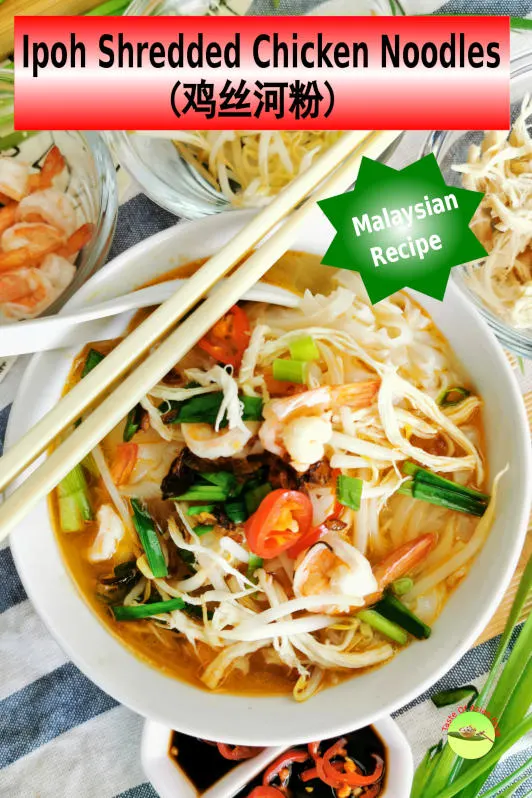
Note: This post may contain affiliate links. Please read my privacy policy for more info. I may receive commissions for purchases made through links in this post. As an Amazon Associate, I earn from qualifying purchases.
What is Ipoh shredded chicken noodles?
The noodles are called 怡保鸡丝河粉 (pronounced as Ipoh gai si Hor Fun or Ipoh kai si hor fun) in Cantonese. As the name suggests, these noodles are the specialty of Ipoh, a city in northwestern Peninsula Malaysia, which is also the capital of the state of Perak. It is one of Malaysia’s most well-known cities, famous for the quality of street food.
Ipoh is a place that brings back numerous nostalgic memories of my early life. My first part-time job as a teenager was at a bookstore in Ipoh Old Town, right opposite one of the most famous coffee shops for Ipoh hor fun with shredded chicken, Thean Chun 天津茶室.
How to make the Ipoh shredded chicken noodles (flat rice noodles/hor fun)?
Although it may not be practical to visit Ipoh just to enjoy a bowl of these flat rice noodles, you can easily reproduce these chicken noodles’ authentic flavor because the ingredients are readily available anywhere.
Here is how to do it.
1. The main ingredients for making Ipoh shredded chicken noodles
a. The flat rice noodles
These flat rice noodles are the specialty of Ipoh. Below is the image of hor fun. Fresh rice noodles have a silky smooth texture and usually is readily available at any wet market or supermarket. It is the thinner variety of kway teow. The thicker type is more suitable for frying.
You can substitute it with the dry version if it is unavailable where you live. Follow the packet instructions to cook it until al dente before use. Alternatively, you can use Chinese egg noodles, although that is not the authentic way served in Ipoh.
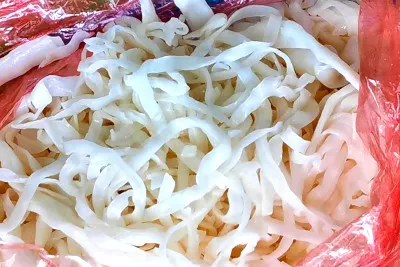
b. Chicken bones
You need chicken bones, not just the meat, to make this tasty light broth.. There are chicken carcasses available at the local market and supermarket. You can improvise using leftover roast chicken bones if you don’t have them.
c. Shrimp heads
Shrimp heads are also readily available at the local wet market. The locals use it to prepare another famous street food called Penang prawn mee. Some home cooks gather and freeze the shrimp heads whenever they cook shrimp. They will cook this dish after they gather enough prawn shells and prawn heads. You can do the same, but I have purchased 1.4kg of shrimp today and managed to get 500g of heads. I only use part of the shrimp meat in this recipe and keep the remainder for my shrimp and asparagus stir-fry and shrimp fried rice.
The broth that is made with shrimp heads is delightful. The flavor is even better if it stir-fries until aromatic before adding to the simmering pot of water.
d. Chicken meat
As the name suggests, hor fun is served with shredded chicken. The chicken breast should be boneless and skinless, and poach in the slow boiling broth until it is just cooked. Rapid boiling will toughen the meat.
Once the chicken breast is cooked, fish it out from the broth, cool it, shred it into thin threads, and place it on the noodles before serving.
You can also use chicken thigh meat, which is more tender and juicier. Some shops also include Chinese barbeque pork (char siew) besides chicken meat.
e. Shrimp meat
The last primary ingredient is shrimp meat. I like to keep the end section of the shrimp shell (the tail) intact because it is more visually appealing. Alternatively, remove all the shells and halve the shrimp lengthwise.
The deveined and shelled shrimps are pouched in the broth. Once cooked, set aside to be used later.
2. The supporting ingredients
The following are the supporting ingredients. Don’t take it lightly if you want to make a bowl of superior Ipoh shredded chicken noodles. Every step is vital to achieving the best quality.
a. Bean sprouts
Ask around people, and most of them will agree that the best quality bean sprouts are from Ipoh. It is likely due to the abundance of hard water from the limestone hills surrounding Ipoh, which contributes to the growth of the crunchy and succulent bean sprouts. The best quality bean sprouts sold in different parts of Malaysia are from Ipoh.
You may not have the luxury of getting such quality bean sprouts where you live, but it is a crucial ingredient to get close to the original recipe.
b. Deep-fried shallots
Deep-fried shallots are used abundantly in Malaysian cuisine. The locals will prepare a large batch and keep it in an airtight container. Sprinkle the fried shallots liberally on top of the noodles. It adds a layer of flavor to various local dishes.
c. Chives and spring onions
Both greens flavor the noodles and make the whole ensemble more colorful. Besides that, some restaurants include Chinese greens, such as choy sum (cai xin or 菜心).
d. Rock sugar
Rock sugar is an elusive ingredient for most non-Asian. The purist vouch that it has a cleaner taste and without the caramel tone. It is widely used to prepare a Chinese dessert called Tong Tsui 糖水, e.g., red bean soup. The flavor without the caramel tone is preferred by most Chinese. It is a personal preference, and I will leave it to you to decide whether you want to use rock sugar or ordinary sugar. I have tried that before, and the difference is insignificant.
e. Seasoning and Garnish
The seasonings are kept to a minimum. These are basic ingredients: light soy sauce, dark soy sauce, salt, and white pepper.
Besides the spring onions, chive, and fried shallots, cut a few slices of red chili to add some color to the whole ensemble. The noodles are best served with some soy sauce and cut chili.
3. Steps to make Ipoh shredded chicken noodles
Now let’s get into the nitty-gritty of preparing hor fun/shredded rice noodles/怡保河粉/鸡丝河粉/flat rice noodles. (It is slightly confusing when I translate it into English, so I just list all the variations to assure you that they mean the same thing.)
a. Simmer the chicken bones
- Wash the chicken bones with water and remove all the debris and offals.
- Place the bones in a stockpot and fill with a large pot of water enough to cover all the bones. Bring the cold water to a boil, then reduce the heat to a bare simmer.
- Skim away the scum floating on the surface to get a clear chicken stock.
- Add the peppercorn and let it simmer over low heat for one hour or until the bones soften and release all the flavor.
Note: Some stores also add some pork bones to enhance the flavor.
b. Stir-fry and simmer the shrimp heads
While simmering the chicken bones, we can stir-fry the shrimp heads on another stove.
- Wash the shrimp heads. Drain.
- Heat 100ml (6 tbsp) of oil in a pan. It is intended to use more oil to fry to yield the excess shrimp oil to drizzle on the noodles later.
- Stir-fry the shrimp heads until fragrant and turn golden, which takes about 15 to 20 minutes.
- Strain the shrimp heads and keep the excess shrimp oil separately.
- Add the fried shrimp heads to the chicken broth and simmer over low heat for 20 minutes until the shrimp flavor is fully extracted.
- Remove the shrimp heads and chicken bones and filter the broth through a fine sieve. If you want it to be extra clean, filter it through a cloth bag or cheesecloth.
- Season with rock sugar and salt. You need to use more salt because it will be served together with the noodles.
- The broth is ready now.
c. Prepare the shredded chicken and shrimp
- Simmer the chicken meat in the clear broth, which takes about 15 minutes. Do not use high heat for cooking the chicken as it will toughen the meat.
- Remove the chicken once it is cooked, i.e., when it reaches 70°C/160°F. Once the chicken is cold, shred it to become chicken floss.
- Put the shrimp into a small colander and poach it in the broth.
- Remove and set aside.
d. Deep-fried the shallots (or store-bought)
- Frying the shallots is quite straightforward. First, slice the shallots thinly.
- Next, deep-fry the shallots in hot oil over low heat until it turns golden brown and crispy. It is better to use low heat to avoid rapid browning, which takes about ten minutes.
- After it becomes crispy and golden, pour it through a wire mesh strainer to remove the excessive oil. You can use The shallot oil to fry the shrimp heads.
- When it is cold, keep the fried shallots in an airtight container.
There are ready-made fried shallots available in the market and supermarkets in Malaysia. I am unsure whether it is available in other places, but you can get it online from Amazon.
e. Assemble and serve
Now it comes to the final part: to assemble everything into one bowl and serve.
- Place hor fun in a colander and blanch in hot water for twenty seconds. Shake off the excess water and place the noodles in a bowl. (If you are using the dried flat rice noodles, you need to boil them in hot water until al dente, similar to cooking pasta.)
- Blanch the bean sprouts and chives in water for twenty seconds. Do not cook the bean sprouts for too long to keep them crunchy.
- Put the hot hor fun in a large bowl, and top with the strips of chicken meat, bean sprouts, shrimps, fried shallots, chives, red chili, and spring onions.
- Ladle the hot broth over the noodles. Add a teaspoon of the fragrant shrimp oil that we have reserved. Serve immediately with light soy sauce and green chili.
Frequently asked questions:
1. Should I add oyster sauce to enhance the broth’s flavor?
Oyster sauce is unnecessary, and I would avoid using it as it will make the taste less authentic.
2. Can I use instant stock purchases from the grocery store instead of making the broth from scratch?
The broth is the soul of the noodle dish. It should be done from scratch. Since there is no store-bought prawn stock available, I would suggest do not take the shortcut but do it yourself.
If you like this Ipoh hor fun recipe, you are likely also interested in making other Asian recipes like the Vietnamese pho and the Hong Kong wonton noodles soup. Please refer to the recipes on this blog if you want to try them.
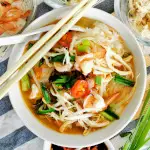
Ipoh shredded chicken noodles
If you are living in Malaysian, you must have heard of the famed Ipoh shredded chicken noodles.
It is called 鸡丝河粉(pronounce as Gai Si Hor Fun) and 怡保河粉 in Cantonese. Hor fun is locally produced flat rice noodles, with a silky texture which is due to the
Ingredients
- 200g (7 oz) shrimp meat
- 400g (0.8 lb) chicken breast
- 1kg (2 lbs) flat rice noodles (Hor Fun)
- 1 Cup Bean Sprouts
- 100 g (4 oz) chives, cut into 3 cm segments
- 3 stalks of scallions, cut into short sections
- 3 stalks of chives
- 3 fresh red chilies, sliced
- 4 tbsp crispy fried shallots
Soup Base
- 1.4 kg (3lbs) chicken bones
- Sufficient water to submerge the chicken
- 1 Tbsp Whole White Peppercorns
- 30g (1 oz) rock Sugar
- 2 tsp Salt
- 500g (1 lb) Shrimp Shells
- 100ml (3.5 oz) cooking oil ( for frying the shrimp heads)
Instructions
Chicken and shrimp broth
- Pace the chicken bones in a pot with cold water enough to cover all the bones. Skim away the scum floating on the surface. Add the peppercorn. Simmer over low heat for one hour.
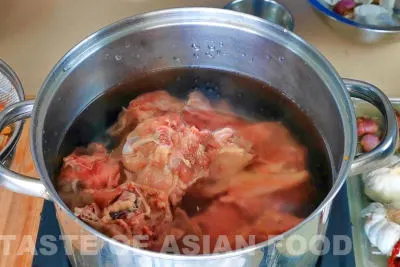
- Stir-fry the shrimp heads until fragrant and turn golden, which takes about 15 to 20 minutes. Strain the shrimp heads and keep the excess shrimp oil separately.
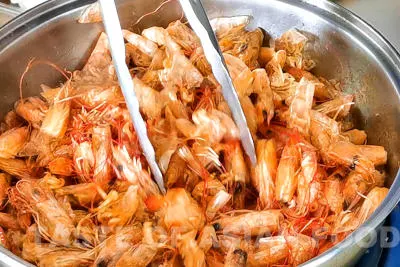
- Add the fried shrimp heads to the chicken broth and simmer over low heat for 20 minutes.
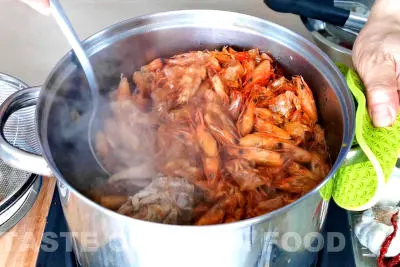
- Strain the broth with a strainer or cloth bag. Season with rock sugar and salt.
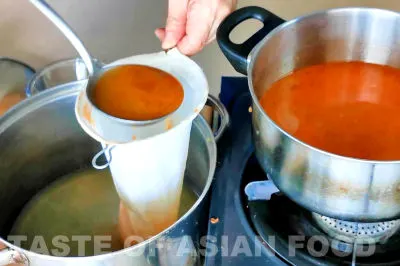
Others
- Simmer the chicken breast meat in the clean stock until it is cooked, which takes about 15 minutes.
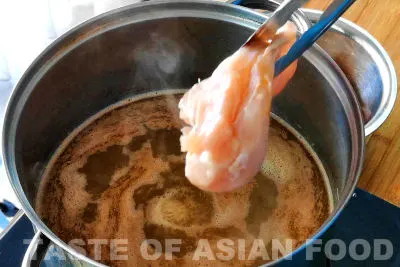
- Shred to become chicken floss.
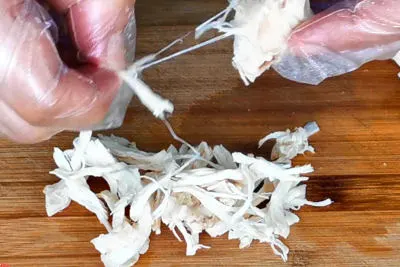
- Poach the shrimp in the broth. Set aside.
- Slice the shallots thinly. Deep-fried over low heat until crispy and brown. Pour it through a wire mesh strainer to remove the excessive oil.
To assemble
- Blanch the noodles, bean sprouts, and chives separately in hot water for 20 seconds.
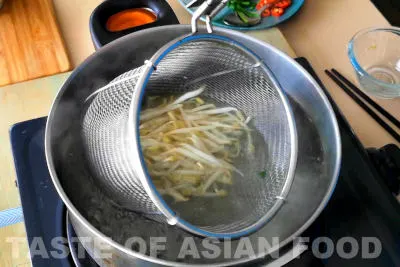
- Put the hot hor fun in a large bowl, top with the shredded chicken, bean sprouts, shrimps, fried shallots, chives, red chili, and scallions. Ladle the hot stock over the noodles. Add a teaspoon of the fragrant shrimp oil and serve immediately.
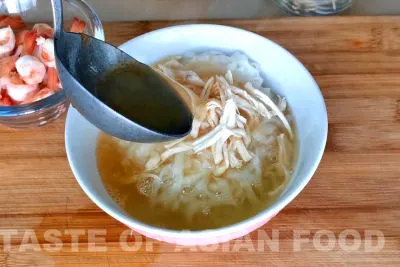
Recommended Products
As an Amazon Associate and member of other affiliate programs, I earn from qualifying purchases.
Nutrition Information:
Yield: 5 Serving Size: 1Amount Per Serving: Calories: 240Total Fat: 10gSaturated Fat: 2gTrans Fat: 0gUnsaturated Fat: 7gCholesterol: 39mgSodium: 1148mgCarbohydrates: 23gFiber: 2gSugar: 4gProtein: 14g
This data was provided and calculated by Nutritionix on 6/6/2020

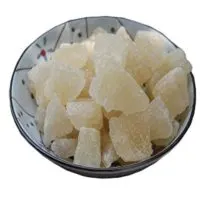
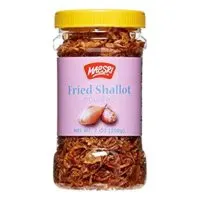
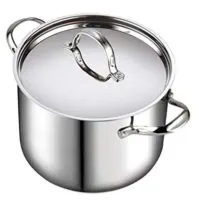
Shrimp and glass noodles in clay pot recipe | 鲜虾粉丝煲
Tuesday 12th of November 2024
[…] Ipoh shredded chicken noodles (怡保河粉). The broth of this soup noodles is also made with shrimp shell and head, plus chicken bones. […]
Ayam goreng - How to make authentic Malaysian fried chicken
Friday 1st of November 2024
[…] you are living in Malaysia, you must have heard of the famed Ipoh shredded chicken noodles. Reserve any chicken bones and shrimp shells to make the broth for the noodles. The flavor is […]
Yi Mein (yee mee / 伊面) - Cantonese noodles recipe - Taste Of Asian Food
Tuesday 24th of September 2024
[…] Ipoh shredded chicken noodles (怡保河粉) […]
Alex
Thursday 5th of August 2021
Talking about the old bookstore opposite Thean Chun coffeeshop, I might know you! I used to patronised that bookstore after school in the early 90's to help my schoolmates to buy books almost everyday and that fat auntie always gave me a lot SPM book sample :) Oh by the way, the actual gai see hor fun from Thean Chun or Kong Heng doesn't serve taugeh together with the hor fun, though it is serve separately because the taugeh will make the broth taste "raw" . I have tried hundred of times, and I still can't get the taste of the soup close to the stall in Thean Chun... they must have been using some secret ingredients or techniques to simmer the broth!
Lola
Thursday 8th of April 2021
Very thorough recipe and steps tq so much.. now I know whats wrong with my sar hor fun, flat taste not like at the coffee shop.
KP Kwan
Thursday 8th of April 2021
Hi Lola, Hor Fun does not have a lot of taste itself, so if I experience this, I will focus on making a more concentrated soup with a stronger flavor. KP Kwan